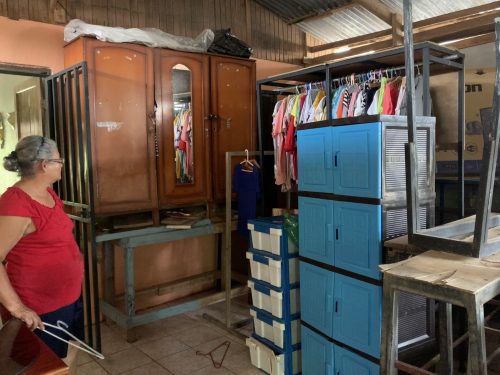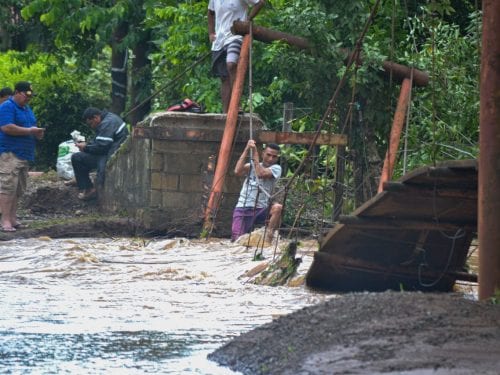
It’s noon on October 17 and the gravel road that crosses through Barrio Estocolmo, Santa Cruz is still waterlogged from the last rain storm.
It’s a community with few sidewalks and no pavement. A place where the prefabricated homes squeezed close together, like many others built with housing bonds. But, as I walk the streets, I notice an eerie difference inside the homes: from the ceiling hang the chairs, the the furniture, even the teddy bears, as if they were piñatas.

Jenndy Pasos, 38, shows her son Ethan’s room at their home in Barrio Estocolmo. He is less than 15 meters from the edge of the river–this year it has flooded twice.
Anayancy Guadamuz opens the gate cautiously. She’s taking care of Josué, her only grandson, while her daughter Patricia works at the hospital where she is an assistant and her other daughter Fabiola is a nurse.
Bakers, barbers and housewives also live on the block and work during the day in downtown Santa Cruz, in Liberia or at their homes. As Ana Yancy tells me this, a sofa balances itself on a cement sink, raised half a meter above the floor. Ropes cross the ceiling where she has hung her and her daughters’ mattresses.

When the river overflowed at the beginning of October, Maria Luz Aguilar, 58, suffered a nervous breakdown. She hasn’t been able to sleep or go out to sell the bread that she takes everyday to downtown Santa Cruz.Photo: César Arroyo
The house was built 30 years ago with a housing bond, like many around here. It smells of humidity and disinfectant. “People asked me, ‘Ana, why did you build your house here so close to the river?’ I don’t even remember it being here when we moved in.”
But for a while now, many residents say that the insignificant river that no one worried about has started to overflow every rainy season.
“I took this door off to make a shelf and we had to build the beds out of cement,” Anayancy says as she takes me through humid, dark rooms.

Anayancy Guadamuz spent a week at her sister’s house after the river overflowed at the beginning of the month.Photo: César Arroyo
“Did you already see this house?,” Ana says to me, pointing at a structure five meters from the edge of the river. That’s where Jenndy lives with his wife and kids. He’s a barber and she paints nails at her house. A year ago, this was one of the 80 homes affected by Tropical Storm Nate. Every time the river rises, the family loses a piece of its land.”
“There used to be a roundabout here where cars would turn around and now look at it. The river took it all,” Jenndy says with the resignation of someone who goes through the same thing every year. He is seated on a bench facing the street, which is full of mud. Inside are toasters and refrigerators stacked on top of beer crates. At other homes in the area, beds, chairs and other furniture rest on cinder blocks.

Carla Castillo, 31, built her house four years ago and she still has another 16 years of payments.Photo: César Arroyo
Families have their own means of resisting what now seems inevitable. They fight this battle every rainy season and the same thing happens in towns such as La Tulita, Tucurrique or Corobicí, Santa Cruz, the president of the Barrio Estocolmo development association, Manuel Ugarte, tells me.

Marcial Guido, 40, took his family’s belongings to the roof of the house he rents with the help of his neighbours.Photo: César Arroyo
At night, those who are able to fall asleep are only half asleep, resting with one eye open. If the rain persists, residents such as Anayancy or Jenndy and their families get up in the middle of the night and check the river. If things don’t look good, they know what to do and begin to raise furniture, leave the house and come back several days later to wash everything.
When I ask residents about potential solutions, some of them tell me that a dike needs to be built or the river needs to be dredged, needs that other Guanacaste communities also have.
Institutions and residents knew the risks communities faced since Tropical Storm Nate last year, but no one did anything to fix it. Why?

Bags of cement remain close to the doors of Manuel Ugarte and his family’s home to prevent water and mud from entering.Photo: César Arroyo
Those who can’t see any solution to the problem can only hope. “I live there, gambling to see if we will be able to leave, because buying a new home now is a dream,” says one woman who buys a lottery ticket every week.








Comments